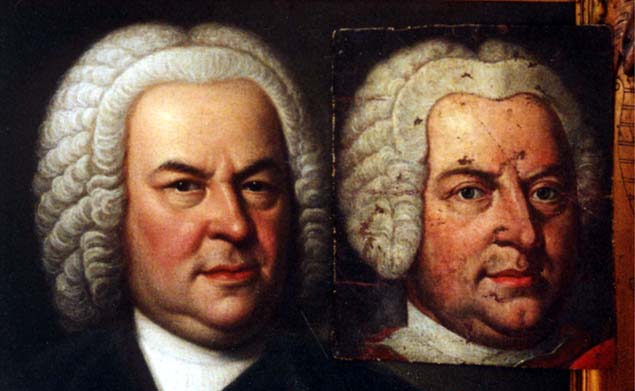The Critical Discographies from Choral Music On Records - Mass in B Minor Pages at the Teri Noel Towe Home Pages
Johann Sebastian Bach
The Critical Discographies from Choral Music On Records
This remarkable photograph is not a computer generated composite; the original of the Weydenhammer Portrait Fragment, all that
remains of the portrait of Johann Sebastian Bach that belonged to his pupil Johann Christian Kittel, is resting gently on the surface
of the original of the 1748 Elias Gottlob Haussmann Portrait of Johann Sebastian Bach.

1748 Elias Gottlob Haussmann Portrait, Courtesy of William H. Scheide, Princeton, New Jersey
Weydenhammer Portrait Fragment, ca. 1733, Artist Unknown, Courtesy of the Weydenhammer Descendants
Photograph by Teri Noel Towe
©Teri Noel Towe, 2001, All Rights Reserved
The Critical Discographies from Choral Music On Records
Mass in B Minor, BWV 232
Mass in B Minor, BWV 232
The First Period Instrument Recordings
By the time of its release, however, Marriner's recording, like other "modern" instrument accounts, was no longer the rule but the
exception. The explosion of interest in period instruments and authentic performance practice had assured that. The first "authentic"
recording was Nikolaus Harnoncourt's. It exploded on the Bach world like a bombshell in 1968; depending on one's point of view,
it came as a revelation, or a shock, to all who heard it. [38] Five sterling soloists, a crack ensemble of "original" instruments, and a
superbly trained chorus of men and boys that fluctuates in size from 42 to sixteen, participate in this streamlined, fleet, but sincerely
felt performance. If the illustrations in the booklet that accompanied the original LP release of this recording may be taken as an
accurate indicium, the actual conducting was shared by Harnoncourt, who was in charge in the arias and the duets, and Dr. Hans
Gillesberger, the director of the Wiener Sängerknaben, who led the ensemble in the choral numbers.
Via this inestimably valuable recording, which remains the only period instrument account in which a boys' choir is used,
Harnoncourt and his colleagues revealed facets of the Mass not clearly apparent before. Counterpoint and tone colors obscured to
some degree by the different characteristics of modern instruments, characteristics that Bach's internal musical ear could never have
anticipated, now began to come out of the mists; all of a sudden, the Mass could be heard with a clarity akin to that of a sunny
alpine morning. But Harnoncourt's is neither a clinical nor a "scholarly" performance in the pejorative sense of the term. It has life, it
has pizzazz, it has fizz, it has verve.
Harnoncourt re-recorded the Mass, still with a period instrument ensemble but with a mixed choir, in 1985. [39] Though the soloists
are all first rate (Only Kurt Equiluz returned from the 1968 cast.), the larger chorus of female and male voices combine with
marginally, but noticeably, slower tempos to make this second version less exciting, less emotionally compelling, and less
transparent than the first.
Joshua Rifkin's 1982, Gramophone Award winning, recording of the Mass was every bit as important a trailblazer as Harnoncourt's
1968 set had been fourteen years earlier. [40] Rifkin's intensely powerful, revelatory reading reflects the iconoclastic results of his
painstaking and open minded researches into Bach's performance practices. In seeking to understand the documentary evidence in
light of the philological evidence of Bach's original performing parts, rather than the other way around, Rifkin arrived at the startling,
but obvious -- at least, to the open-minded -- conclusion that every performer got his own part from which to sing or play, which
means that, unless doubling parts are present, the vocal lines are meant to be sung by but one singer, even in the choruses. With a
superb complement of vocalists and musicians, Rifkin put his conclusions into practice, and the resulting recording establishes the
criteria, both scholarly and interpretative, by which all purportedly authentic recorded performances of the Mass in B Minor must
be judged.
Rifkin was fortunate in being able to assemble a group of top-drawer singers and instrumentalists as committed to his "radical"
conclusions as he is. Collectively, they had the guts to sing and play with vigor and sensitivity, warmth and understanding,
confronting the listener and the Bach scholarly establishment with vibrant, musical proof of the accuracy of Rifkin's conclusions.
Never have the instrumental and vocal lines in the Mass sounded so clear and so well balanced. Never has the first "Kyrie" sounded
so baldly plangent. Never have the fugal episodes in the "Cum sancto spiritu" and the "Et resurrexit" unfolded with such exhilarating
clarity. Never has the "Confiteor" glided into the "Et expecto" so intimately, so personally.
The Bach scholarly community, of course, does not like to be told that its analysis of the documentary and philological evidence is
wrong, and has been wrong, for decades. The traditionalists and vested interests, therefore, have fought a valiant rear guard action
in defense of the status quo. Few, therefore, have so far had the courage to follow Rifkin's lead and dispense with the customary
choral complement. One of those is Andrew Parrott, who forthrightly acknowledges his debt to Rifkin in the annotations to his
recording of the Mass. [41] Even Parrott does not follow Rifkin's lead entirely, for in some of the choruses he allots two singers
two each line. His decision to do so is defensible in theory, for, the year before he died, shortly after he had finished assembling the
second half of the Mass, Bach put on a performance of the Saint John Passion in which there were two singers to each vocal line
in the choruses.
Parrott's is an exciting, if too often breathless, reading of the Mass; the "Benedictus", for instance, is so brisk that it borders on the
flippant. But this interpretation has a clout and a character that put it in the same league with Rifkin's, head and shoulders above the
other "more traditional" accounts that have been made in recent years. And, like Rifkin, Parrott is blessed with excellent singers
(including three fine boy altos from the Tölzer Knabenchor) and instrumentalists.
In comparison to the Rifkin and the Parrott sets, almost all of the other recent "authentic" recordings of the B Minor Mass seem
remarkably "old fashioned", and, in one or two instances, downright stodgy. Gustav Leonhardt's account, with La Petite Bande and
the Chamber Chorus of the Nederlandse Bach Vereiniging, is perhaps the drabbest overall. [42] Almost completely devoid of
excitement, it is fussy, colorless, and puritanical, a dessicated interpretation preserved in the musical equivalent of the natron used
to dry out mummies in pharaonic Egypt. The technically unimpeachable singing and playing of the majority of the participants
cannot save this performance, and matters are not helped by the dry as desert sand tone of bass Harry van der Kamp. About the
only bright spot in the whole production is Max van Egmond's reliably warm, clear, and wonderful singing in the "Et in spiritum
sanctum", but even then, it's a mixed blessing, for Leonhardt's insistent stressing of the strong beats makes the aria sound
sing-songy. Nearly as dull is the Joachim Martini set, a provincial production featuring four respected soloists and first class period
instrumentalists. [43] The Mass is sung and played with journeyman precision; this dry as dust reading is a superfluity.
Philippe Herreweghe's recent recording of the Mass, on the other hand, is joy to the ear. [44] It is the gentlest and most
introspective interpretation on records, magnificently paced, and both taut and exciting when the mood requires. His twenty-one
member Collegium Vocale, Ghent, sings the choruses with an enthusiastic and energetic accuracy, and his quintet of soloists is also
first rate, particularly male alto Charles Brett and tenor Howard Crook.
John Eliot Gardiner's 1985 recording is in some ways a traditionalist scholar's reaction to the Rifkin approach; he makes use of
concertisten in the first "Kyrie", the "Gloria", and the "Crucifixus" (which is sung entirely by soloists, à la Rifkin), but his
application of the "solo/tutti" principle is much more conservative than Robert Shaw's had been a quarter of a century earlier. [45]
Gardiner parcels the solos out among numerous members of his Monteverdi Choir; the quality of the singing and the ensemble, is
very high indeed. Gardiner's crisp and energetic reading is a performance of the Mass that will give much pleasure to those who
want an authentic performance with a chorus in the modern sense of the term.
Please click here to advance to Page 9 - Summary.
Please click here to visit the Endnotes Page.
Please click here to visit the Alphabetical Discography Page.
Please click here to return to the Critical Discographies from Choral Music On Records Main Page.
Please click on  to return to the Johann Sebastian Bach Index Page.
to return to the Johann Sebastian Bach Index Page.
Please click on the  to return to the Teri Noel Towe Welcome Page.
to return to the Teri Noel Towe Welcome Page.
teritowe@alumni.Princeton.EDU
Copyright, Teri Noel Towe, 1989, 1997, 2001
All Rights Reserved
The The Critical Discographies from Choral Music On Records - Mass in B Minor Pages at the Teri Noel Towe Home Pages
are PPP Free web pages.

The The Critical Discographies from Choral Music On Records - Mass in B Minor Pages at the Teri Noel Towe Home Pages
have received the HIP Woolly Mammoth Stamp of Approval from The HIP-ocrisy Home Page.